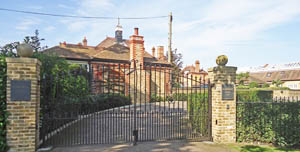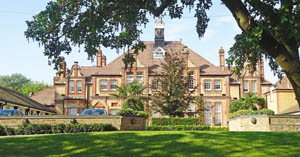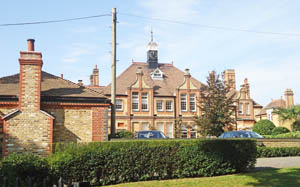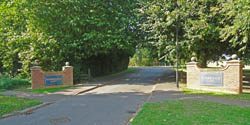Open Air School
In 1885 West Ham Borough Council built, at a cost of £8,000, a 'Truant School' in Fyfield, Essex, for up to 80 boys. The purpose-built building was surrounded by 20 acres of grounds. It later became the West Ham Truant Industrial School. In 1907 it was certified as the Fyfield Certified Industrial and Truant School for 80 boys (increased in 1912 to 110 boys).
The School closed in February 1925 and the Borough Council converted the premises into a residential open air school for delicate children.
The Fyfield Open Air School opened later in 1925 and initially housed some 80 boys. It was also known as the West Ham Open Air School.
In 1931 a new block was added to provide places for 60 girls as well. By 1938 the school accommodated about 150 girls.
As with other open air schools, lessons were held in classroom huts, open on one or more sides (remembered as being cold, except in the corner next to the heating pipes!) Some classes were taken in the open fields - traces of a large ring of seats are still visible.
Country walks, playing in the surrounding fields and folk dancing were all part of the regime.
Meals were taken in a large wooden hall, on long wooden tables and benches, with enamel mugs and plates.
A typical breakfast consisted of brown bread with warm milk and a stodgy porridge - eat up or do without.
For lunch pea soup seems to have appeared too often for some. The autumn harvest brought a glut of baked apples to the menu.
One regular treat from the school nurse - cod liver oil mixed with malt - was good enough to lick the spoon clean.
Classes and lunch would be followed by a compulsory long afternoon nap on camp beds in the hall.The boys slept in three dormitory blocks, while the girls had separate buildings - out of bounds to the boys. Dormitories, too, were open on one side. During winter the sheets never became warm and there was a likelihood of snow to be found in the morning on the ends of the beds nearest the open windows.
By the late 1930s the School consisted of a considerable collection of buildings. The high ceilings of many of the rooms in the main building impressed young minds. On return to their families, some found that their homes appeared cramped and claustrophobic in comparison. In the 1930s it was noted that children from the East End, who had been sent to the School undernourished and ill, returned quiet, well mannered, subdued and well spoken.
The pupils all wore uniforms, except for church on Sunday mornings, when letter writing was followed by a walk through the country lanes and village to the church - girls ahead, boys following behind. After church, the children walked back to the School and changed back into their uniforms.
Visits from parents and relatives were strictly limited, being allowed only at weekends. In 1938, it is reported that visitors were permitted only on one afternoon every three months.
In 1939, as war loomed, the School was closed. The pupils changed from their uniforms into their own clothes, collected their belongings, and were bussed back to their families in West Ham, just as other buses arrived bringing sick and orphaned children evacuated from hospitals and children's homes in London.
Although at the beginning of WW2 the School was listed as joining the Emergency Medical Scheme, it is unclear if it was used as an emergency hospital. It later resumed school activities, carrying on through the war years. The cellars, or 'dungeons', were used as air-raid shelters and were fitted with rows of wooden bunks. Classes would have been disturbed regularly by the roar of bombers from the nearby USAAF base at Willingate.
The School remained open after the war, though now characterised more as a children's convalescent home for those needing long-term care of a year or more to recover from rheumatic fever.
By the mid 1950s, however, improved standards in living conditions and healthcare provision resulted in a declining demand for the facility. The School closed in 1956.
Present status (September 2013)
Following closure of the Open Air School, Essex Local Education Authority reopened it in 1958 as Fyfield Boarding School, initially mixed and later for boys only.
In 1980 the School merged with two other Essex boarding schools - Hockerill and Elmbridge. The latter moved into the Fyfield premises, which then became the Elmbridge Boarding School until the 1990s.
The main building survives as Elmbridge Hall. It was converted into 18 luxury apartments around 2001. The grounds of the former Open Air School have been redeveloped as Elmbridge Gate, a small housing estate, entered via Forest Drive off Ongar Road, to the north of Elmbridge Hall.

The main entrance to the gated community of Elmbridge Hall.

Elmbridge Hall, as seen from Ongar Road, is obscured by trees. The building is 2- to 3-storeys high and was built of gault brick with red-brick dressings.

Elmbridge Hall seen from the driveway.

Forest Drive, off the Ongar Road, leads to Elmbridge Gate.
Written account found in his possession by his son Peter Thorne when Albert passed away aged 91 in November 2019
Open Air Schools by Albert Jospeh Thorne
I was born in 1928 and lived in 67 Star Lane, Canning Town, London. My father died in March 1938 of tuberculosis. There were three children at the time, myself and two younger sisters who contracted the disease. We attended a local TB Clinic in Balaam Street for regular X-rays and jars of cod liver oil and malt.
In 19?? aged ?* I was sent to Fyfield Open Air School 2 miles from Ongar in Essex. It was (or rather is) now a private school; a large 3-storey country house-type building with a covered quadrangle in the front.
On arrival I was issued with 3 sets of grey uniforms, allocated a locker in the Recreation Room and a bed in a large dormitory.
The normal routine was to get up at 7 a.m., wash and dress, then go down to a shed adjacent to the house to clean and polish shoes. You then had to run a lap round a very large field before breakfast. There were no overcoats or heavy clothing and no heating at all anywhere. You were frozen stiff in the winter, even the beds had only one blanket.
After breakfast in the main hall, assembly was held on the covered outside quad (roof on glass roof only), when letters and parcels were distributed after prayers and hymns.
School classes were held in sheds in the grounds. These had large half panels in the sides which were only closed in desperate weather.
Dinner - the midday meal. All meals were in the main hall. The quality and quantity of the food was very good. Supervision at meals was strict; you had to eat it all! I could not stand the cod in white sauce on Fridays and had to sit there all day with it till teatime.
Before school started you could fall out for sick parade. The main problems were chilblains (treatment: a very large spoonful of cod liver oil neat!) or scuffed sore legs, where the short rough trousers wore grooves in your frozen legs (treatment: ointment). Cold sufferers were given 2 tablespoons of cod liver oil and malt.
After tea you could go to the Recreation Room until supper. I remember fretwork was all the rage if you could persuade your parents to send you a set.
At 7.30, suppertime. This was a mug of cocoa or chocolate, with your choice from a large wooden tray of bread and marge with cakes or anything left from teatime. Then wash and bed.
On Fridays after tea it was bath night. You collected your clean set of uniform clothes, putting them in a cubby hole in the Clean Room, stripped, leaving your dirty clothes to be collected, then went through a corridor-type shower, warm, warmer, then cold! Rough, hard towels. After dressing at 7 p.m. the tuckshop opened! For half an hour, you could purchase (if you had any money!) sweets, Mars bars, biscuits, fret saw blades, notepaper, envelopes and stamps but to store in your locker for the coming week. A magic day!
Most of the children there were desperately unhappy (including me!) Crying in the dormitory at night was rife and reverting to bed wetting often occurred. The staff were generally kind, but strict, but there was no corporal punishment. The main cause of unhappiness was that the length of your "sentence", as it was generally perceived (to the extent of calling the place 'Borstal' by the boys) was not known. Escapes were the main topic in the dorm and attempted by some. The only escape route was the 2-mile road to Ongar and the Headmaster in his sports car used to catch you before you reached it. However, being cunning little East Enders, a way was found. Anyone with spots or sores likely to be contagious was not allowed by the other boys to attend sick parade until they rubbed against and breathed on all the boys in the Boot Shed for a period of 3 days or as long as they could. As a consequence, contagious diseases spread like wildfire to the amazement of staff. The 'lucky' children were taken by ambulance to hospitals in London. I can't remember which disease I contracted, but I had escaped!
I was later due to be returned to Fyfield but while waiting with my mother for the coach to take me back at Balaam Street Clinic, I ran away to a local department store and hid until the coach had left. I got a clump round the ear from my mum, but never returned until 20 years later to find it being used as a private school, but virtually untouched.
I am pleased to say both my sisters and I were cured of TB. How I don't know as it was before any cure was known!**
_________________________
* My father was obviously uncertain of the date. However, I know he was evacuated to Oxford in the first part of the war but returned later and spent part of the Blitz living with his mother back in Canning Town. I think it is likely he was sent to Fyfield soon after his father died (in the written document I found, my father was unsure of his father's date of death but I found a Memorial card confirming it to be March 1938. A good estimation would suggest my father must have been at the School in 1938/39 aged 10/11.
** A cure for TB was discovered in 1944 with the first use of streptomycin in antibiotics.
Peter Thorne
Dennison FR 1953 Annual Report on the Health Services. County Borough of West Ham, 68-69,80-81, 83, 90.
Dudgeon JP 2008 Our East End. Memories of Life in Disappearing Britain. London, Headline Publishing Group, 16.
Langdon DM 2015 Apple Pie Beds and Eggy Bread. Cirencester, Mereo, 27-28, 34.
Rowse T 2002 Nugget Coombs. A Reforming Life. Cambridge University Press, 65.
van Dyk A 2019 Information Wanted Fyfield Boarding School. Fyfield Focus (February/March), 22-23.
http://planpub.eppingforestdc.gov.uk
www.bbc.co.uk
www.british-history.ac.uk (1)
www.british-history.ac.uk (2)
www.british-history.ac.uk (3)
www.childrenshomes.org.uk
Return to alphabetical list
Return to home page